Audio Science Pal
Member
- Joined
- Feb 22, 2022
- Messages
- 61
- Likes
- 95
I agree with the previously mentioned comments that the wall of glass windows is more of a concern than the ceiling.




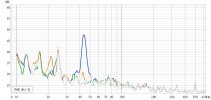
Based on amir's mention that DSP can help with resonances (and because I upgraded front L/R), took a few new measurements today. one with no processing at all, one with DLBC on, and one with my HTP1 in Dirac Bypass mode. I don't see in the manual exactly what that does, but i figured why not
EVen with DLBC on, I presume all recommendations in this thread still stand?
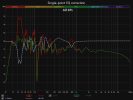
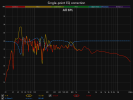


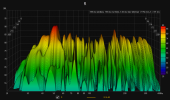
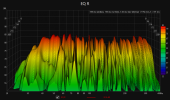
For real?The ceiling is quite high so I doubt that you are hearing much from reflections from it.
Yes. My room is acoustically good but I'd still be happy to swap anytimeBeautiful room. Horrible for sound in a lot of ways, but beautiful. I would much rather listen to music in that room with all the issues than listen to perfect sound at my desk.
There are different schools of thought on room acoustics. But one has to treat the room and speakers as a system. And that means the room acoustics have to work with the radiation patterns of the speakers and the design philosophies of the speaker designers. If you have speakers that were borne out of the Toole/Olive school of speaker design it makes perfect sense to keep the side walls reflective.I tried out @amirm 's general advice not to absorb sidewall first reflections and removed panels I had in those locations - I am a believer now, since removing them didn't harm the precision of the soundstage imaging and resulted in a nice, albeit modest, widening of the perceived soundstage.
But for ceilings I remain a firm believer in absorption, if you are experiencing audible flutter echo or reverb-based loss of clarity in the midrange and treble frequencies. In my experience it doesn't need to be done all over the ceiling - it's not a restaurant with people talking everywhere, it's a residential room with the speakers and prime listening position each in a single, well-defined area. Something like a 4-ft by 4-ft square, aka two standard 2x4 panels, about halfway between the speaker baffles and the seated listening position, can in my experience really deaden an excessively reverberant room at the listening position.
As for thickness, my understanding is that a 6-inch panel should give you pretty effective absorption from about 1kHz on up, and a 4-inch panel might do fine too for all I know.
As always, happy to be corrected by Amir and/or any of our more knowledgeable members.
Except it doesn't work that way. Your brain adapts to those constant reflections and filters them out.OTOH if one comes from the school of thought that anything added by the listening room is a coloration and only conflicts with the content and spatial cues on the recording then side wall reflections, all reflections are unwanted.
Except it does work that way. Your brain has to work overtime to do the filtering and the conflicts are never fully resolved. Preferences are unarguable but the differences are real and quite audible. Room reflections do conflict with the content of the recordings and spatial cues as well as clarity are compromised.Except it doesn't work that way. Your brain adapts to those constant reflections and filters them out.
Where this doesn't work is when reflections are late arriving as to be considered secondary events. Or be long enough to interfere with speech intelligibility. For these, you can look at RT60 or just listen in the room and determine how live it is.
EQ with additional bass drivers helps... but not for everything.
If that were my room, I would play with the toe of the speakers. Maybe crossing in front of the listener, to bring down sidewall first reflections, maybe more toed out. I would try to find a set up where my problematic modes were least problematic.
Then I would EQ as much as I could.
Then I would call it a day.
But, depending on what is behind the listener, I might (might) treat the heck out of the back of the room. Let the front be the front, try to kill as much sound that went past me as possible.
Those speakers don't really have a narrow horizontal disperson. You'll get pretty strong reflections from both side walls with such radiation pattern.
I would considering building something thicker myself here and put in between some of the beams and perhaps combine it with some diffusion if aesthetics allow it. Covering the whole ceiling with something too absorptive of highs wouldn't be a good choice, though the room IMO badly needs something to break up flutter echo and minimize reflections.
I don't have any in mind as I don't know your budget or what you can live with in size.Can you give some examples of speakers that you have in mind? How thick for in between the beams? The aesthetics aspect is the (very) hard part
Not sure what's happening from 140-175Hz on R side (attached), though.

Except it does work that way. Your brain has to work overtime to do the filtering
and the conflicts are never fully resolved. Preferences are unarguable but the differences are real and quite audible. Room reflections do conflict with the content of the recordings and spatial cues as well as clarity are compromised.
Yes. Edgar Choueiri and his team at Princeton have done so extensivelylol, has anyone measured this overtime effort?
Yes. Edgar found this to be a major source of listener fatigue.Is it what people mean by 'listener fatigue'?
Envelopment certainly is something most listeners prefer. And one can get it through different means. No doubt when Toole did his research his findings were that envelopment via side wall reflections was mostly preferred to none in a two channel stereo playback system. But it is limited in its effectiveness, not true to the source material and comes with baggage. That being a far more reverberant room. Those reflective walls are not limited to first order reflections. They are the gift that keep on giving for the entire RT 60.Toole was concerned with 'envelopment' , which his and others' research showed was desirable to some -- mainly consumers, less so music production engineers.
Yes. Edgar Choueiri and his team at Princeton have done so extensively
Yes. Edgar found this to be a major source of listener fatigue.
Envelopment certainly is something most listeners prefer. And one can get it through different means. No doubt when Toole did his research his findings were that envelopment via side wall reflections was mostly preferred to none in a two channel stereo playback system. But it is limited in its effectiveness, not true to the source material and comes with baggage. That being a far more reverberant room. Those reflective walls are not limited to first order reflections. They are the gift that keep on giving for the entire RT 60.
And now we have other, newer and better means of achieving envelopment. Multi channel and cross talk cancellation. And in the case of cross talk cancellation we have a means that does not add to or alter the original source material for standard two channel stereo recordings. Unfortunately for multichannel most of the body of stereo recordings will require some revisionism in upmixing to achieve envelopment.
But for either of these newer ways of achieving envelopment the less we hear the listening room the better they work.
And even back when Toole did the research and drew upon previous research that suggested side wall reflections were a good thing there was not a consensus. Ethan Winer and James Johnston both agreed then and still do agree that hearing the listening room is an undesirable thing.
Have a candy bar and you will reward your brain with all the calories it needs for that work.Except it does work that way. Your brain has to work overtime to do the filtering and the conflicts are never fully resolved.
You must be going crazy listening to your loved ones talking in rooms with all those reflections. I suggest buying a lot more candy bars to reward it.Preferences are unarguable but the differences are real and quite audible. Room reflections do conflict with the content of the recordings and spatial cues as well as clarity are compromised.
How is your brain deriving more enjoyment with reflections if according to your concept it is struggling with it? Surely that is a reward that it likes to see...If you are happy adapting to compromised playback that is a personal choice. If you like the added coloration of early side wall reflections that is a preference that I will not argue.
I have no problem adapting to a portable speaker to enjoy music on the road and at work. But I prefer uncompromised playback when given the option.
